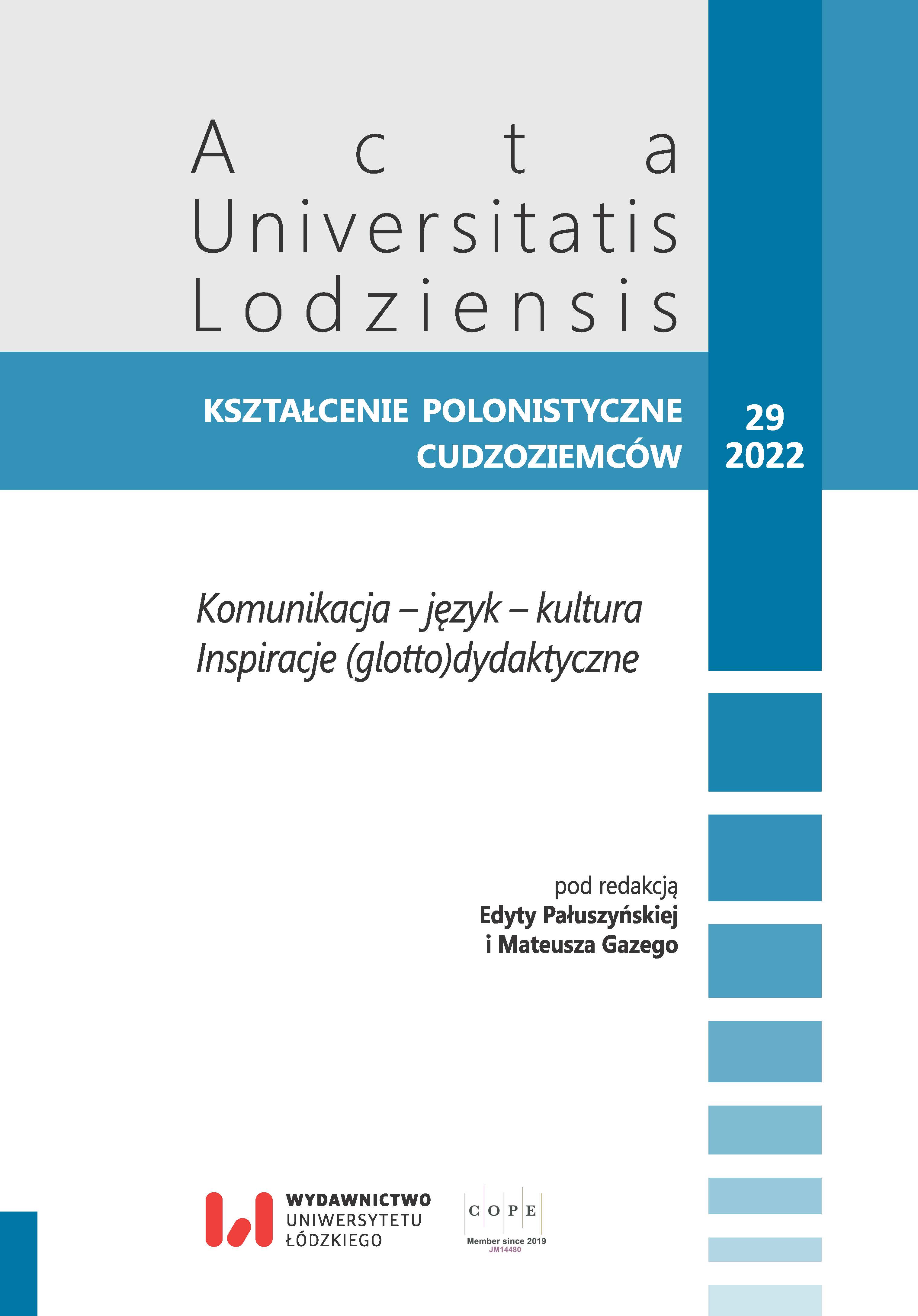Translation as a Primary Didactic Tool in Translation Training. Preliminary Remarks
DOI:
https://doi.org/10.18778/0860-6587.29.07Keywords:
methodology of foreign language teaching, translation studies, eaching Polish as a foreign language, translators´ training programs, CEFRAbstract
The aim of this article is to outline the problem of foreign language teaching in translation studies. The author postulates that translation should be an integral part of not only traditional translation classes, but also language courses. He argues that it is necessary to implement mediation activities, which include translation. Mediation holds an important place in the Common European Framework of Reference for Languages (CEFR), yet its potential seems to be still underestimated. One of the teaching approaches that use multilingualism and mediation is the so-called plurilingual (integrated) approach, which aims at teaching plurilingual communicative competence (PCC) and thus supporting interlingual and intercultural communication. The last part of the article examines the classification of translation competencies proposed by the PACTE research group (2018).
References
Berlitz M. D., 1907, The Berlitz Method for Teaching Modern Languages, New York.
Google Scholar
Broeck R., 1978, The concept of equivalence in translation theory. Some critical reflections, w: J. S. Holmes, J. Lambert, R. Broeck (red.), Literature and Translation, Leuven, s. 29–47.
Google Scholar
Delisle J., Lee-Jahnke H., Cormier C., 1998, Terminologie de la Traduction, Translation Terminology, Terminologia de la Traduccion, Terminologie der Übersetzung, Philadelphia.
Google Scholar
DOI: https://doi.org/10.1075/fit.1
Delisle J., Lee-Jahnke H. (red.), 1998, Enseignement de la traduction et traduction dans l’enseignement, University of Ottawa Press / Les Presses de l’Université d’Ottawa.
Google Scholar
DOI: https://doi.org/10.26530/OAPEN_579204
Delisle J., Lee-Jahnke H., Cormier M. C. (red.), 2006, Terminologia tłumaczenia, przekład i adaptacja T. Tomaszkiewicz, Poznań.
Google Scholar
Europejski system opisu kształcenia językowego: uczenie się, nauczanie, ocenianie, 2003, przeł. W. Martyniuk, Warszawa.
Google Scholar
Garncarek P., 2006, Przestrzeń kulturowa w nauczaniu języka polskiego jako obcego, Warszawa.
Google Scholar
Gatenby E. V., 1967, Translation in the classroom, w: W. R. Lee (red.), ELT Selections 2: Articles from the Journal ‘English Language Teaching’, London, s. 65–70.
Google Scholar
Gębal P. E., 2014, Glottodydaktyka porównawcza jako nowa subdyscyplina glottodydaktyki, w: „Lingwistyka Stosowana” 10, s. 37–49.
Google Scholar
Gonzáles Davies M., 2012, The role of the Translation in Other Learning Context: Towards Acting Interculturally, w: S. Hubscher-Davidson, M. Borodo (red.), Global Trends in Translator and Interpreter Training, s. 161–179.
Google Scholar
Harris B., Sherwood B., 1978, Translation as an Innate Skill, w: D. Gerver, W. Sinaiko (red.), Language, Interpretation and Communication, s. 155–170, New York & London.
Google Scholar
DOI: https://doi.org/10.1007/978-1-4615-9077-4_15
Krings H. P., 1986, Was in den Köpfen von Übersetzern vorgeht, Tübingen.
Google Scholar
Kußmaul P., 1995, Training the Translator, Amsterdam/Philadelphia.
Google Scholar
DOI: https://doi.org/10.1075/btl.10
Kußmaul P., 2000, Kreatives Übersetzen, Tübingen.
Google Scholar
Lado R., 1964, Language Teaching: A Scientific Approach, New York.
Google Scholar
Lörscher W., 1991, Translation Performance, Translation Process, and Translation Strategies, Tubingen.
Google Scholar
Malmkjær K., 2008, Language learning and translation, w: Y. Gambier, L. van Doorslaer (red.), Handbook of translation studies, s. 185–190, Amsterdam.
Google Scholar
DOI: https://doi.org/10.1075/hts.1.lan1
Malmkjær K. (red.), 1998, Translation and Language Teaching: Language Teaching and Translation, Manchester.
Google Scholar
Martyniuk W., 2021, ESOKJ 2020: nowy, zmodernizowany europejski system opisu kształcenia językowego.
Google Scholar
DOI: https://doi.org/10.31261/PS_P.2021.28.12
PACTE Group, Amparo Hurtado Albir (principal investigator), Anabel Galán-Mañas, Anna Kuźnik, Christian Olalla-Soler, Patricia Rodríguez-Inés & Lupe Romero (research team, in alphabetical order), 2018, „Competence levels in translation: working towards a European framework”, w: „The Interpreter and Translator Trainer”, 12:2, s. 111–131, DOI: 10.1080/1750399X.2018.1466093
Google Scholar
DOI: https://doi.org/10.1080/1750399X.2018.1466093
Presas M., 2000, Bilingual Competence and Translation Competence, w: Ch. Schäffner, B. Adab, Developing Translation Competence, Amsterdam/Philadelphia, s. 19–31.
Google Scholar
DOI: https://doi.org/10.1075/btl.38.04pre
Pym A., 2010, Exploring Translation Theories, London and New York.
Google Scholar
DOI: https://doi.org/10.4324/9780203869291
Szafraniec K., 2020, Kształcenie kompetencji translatorycznej. Wstępne rozważania teoretyczne, w: G. Zarzycka, B. Grochala (red.), „Acta Universitatis Lodziensis. Kształcenie Polonistyczne Cudzoziemców”, t. 27, Łódź, s. 407–419.
Google Scholar
DOI: https://doi.org/10.18778/0860-6587.27.23
Vinay J. P., Darbelnet J., 1958, Stylistique Comparée du Francais et del’ Anglais: Méthode de Traduction, Paris.
Google Scholar
Zarzycka G., 2008, Opis pedagogiki zorientowanej na rozwój kompetencji i wrażliwości interkulturowej, w: W. Miodunka, A. Seretny (red.), W poszukiwaniu nowych rozwiązań. Dydaktyka języka polskiego jako obcego u progu XXI wieku, Kraków, s. 63–78.
Google Scholar
Zarzycka G., 2018a, Mediacja kulturowa jako niedoceniony wymiar glottodydaktyki, w: P. Potasińska, M. Stasieczek-Górna (red.), Wyzwania glottodydaktyki polonistycznej. Życie zaczyna się po sześćdziesiątce, Warszawa, s. 117–131.
Google Scholar
Zarzycka G, 2018b, Podejście interkulturowe w nauczaniu języka polskiego jako obcego. Bilans i perspektywy, w: A. Achtelik, K. Graboń (red.), Polonistyka na początku XXI wieku. Diagnozy, koncepcje, perspektywy, t. V: W kręgu (glotto)dydaktyki, red. naukowa całości (t. I–VI) J. Tambor, Katowice, s. 534–548.
Google Scholar
https://www.postscriptum.us.edu.pl/wp-content/uploads/2021/12/11_Martyniuk.pdf [04.06.2022].
Google Scholar
Downloads
Published
How to Cite
Issue
Section
License

This work is licensed under a Creative Commons Attribution-NonCommercial-NoDerivatives 4.0 International License.










